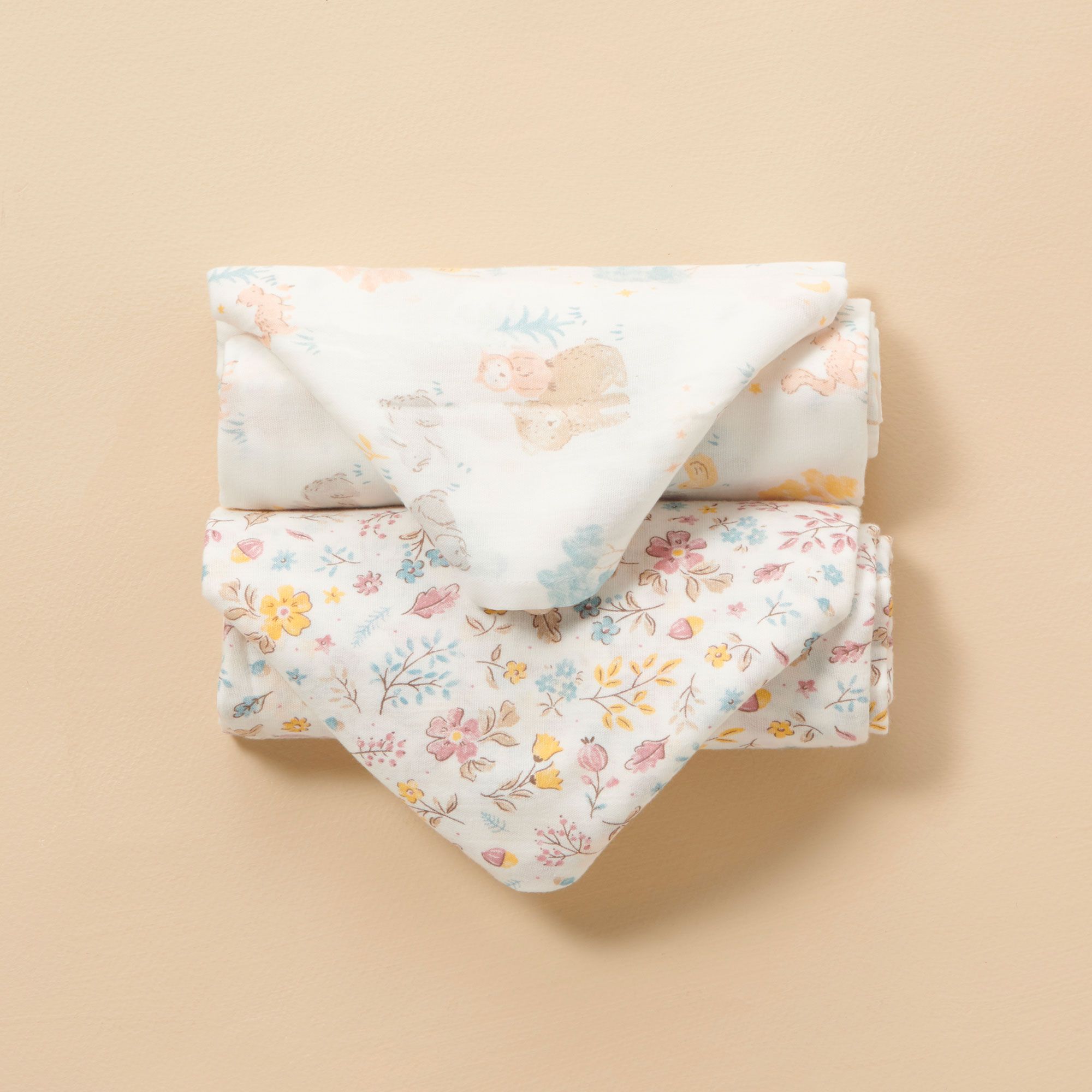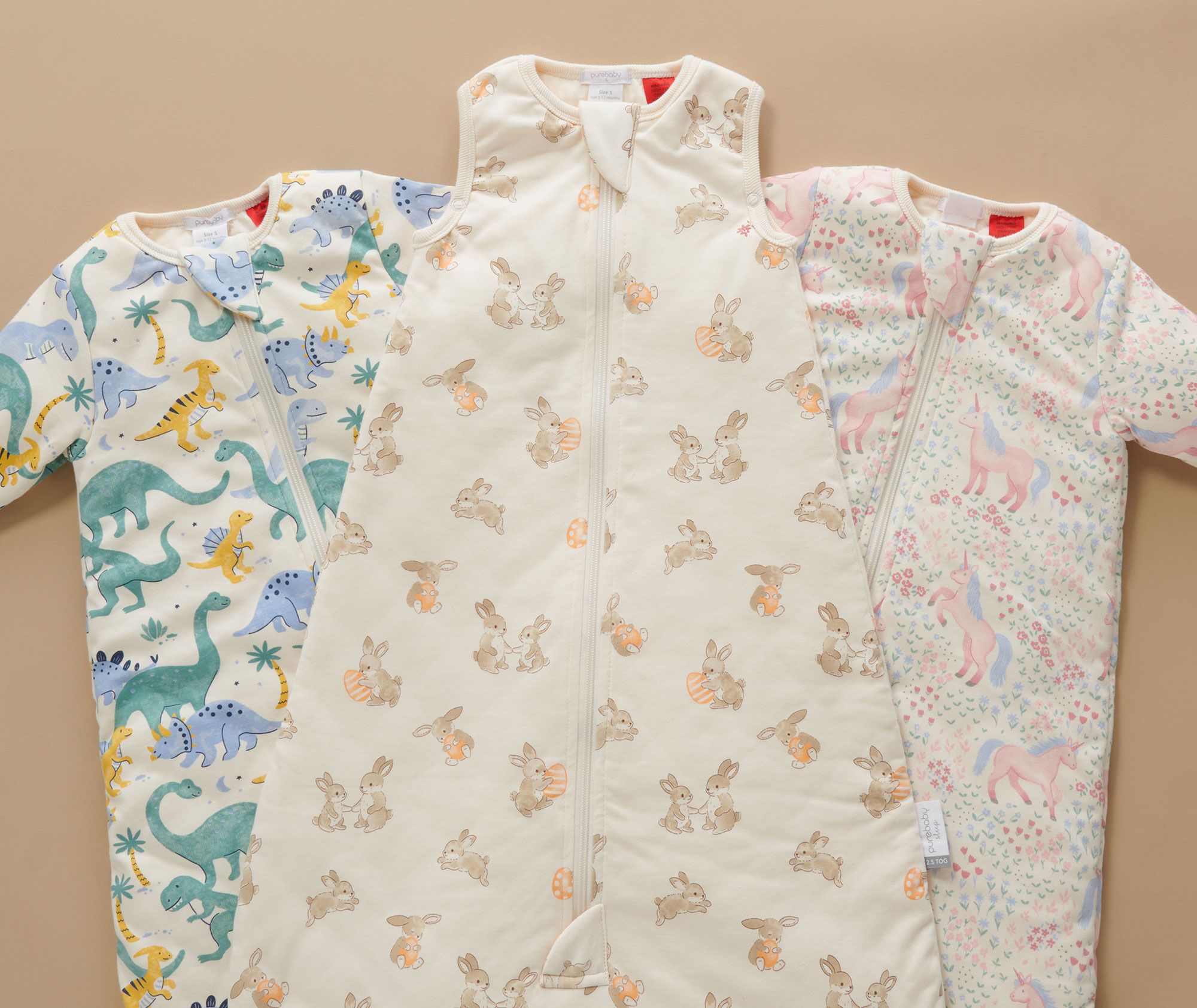
Newborn Essentials List - Everything You Need!
10 min read | 20 May 2024
8 min read | 26 August 2024

Young babies spend a lot of time sleeping, and it's important to ensure they're comfortable and safe during nap time and overnight. Both swaddles and sleeping bags provide little ones with a sense of comfort and safety, helping them to settle and (hopefully!) sleep longer. But many parents often wonder what the difference is, and which one is right for their baby.
In this post, we'll share the key differences between swaddles and sleeping bags and the advantages for each, as well as what to consider when choosing the best option for your baby's bedtime.
A swaddle is a piece of fabric that wraps snugly around your baby's arms, legs and body, mimicking the cosiness of the womb.
You can swaddle your baby from birth until they start to show signs of rolling. When done correctly, swaddling can help young babies to settle and sleep on their backs in those early months.
Newborn babies have a startle reflex, where they extend their arms or legs in response to sound or movement. It's for this reason that newborns are usually swaddled with their arms folded across their chests. Once their startle reflex is gone (usually around three months), you can leave your baby's arms free so they can self soothe.

Swaddling is the practice of wrapping your baby securely in a lightweight blanket or cloth to their shoulders, restricting their movement and providing comfort.
There are several different techniques you can use for swaddling your little one. Regardless of the technique you use, always make sure that your baby's head remains uncovered, and that the swaddle blanket is not too tight around baby's hips and legs. Wrapping the legs too tightly may cause hip problems, such as hip displasia.
To create a safe sleeping environment for your little one, dress baby in layers depending on the temperature of their room, swaddle your baby correctly, then place baby on their back in their cot or crib. Avoid putting toys or cot bumpers in the cot or crib, as these may cover your baby's face and obstruct breathing or cause overheating.
Helps to settle and soothe newborns
by recreating the feeling of being in the womb
Reduces the startle reflex by restricting arm movement
, promoting longer and more restful sleep
Helps babies to sleep on their backs
, which is the safest sleeping position
Swaddles are best suited for newborns and young babies who may need some help with settling and sleeping. They're thought to provide them with a feeling of security and comfort, as they mimic their position they had in the uterus.
However, it's worth noting that not all babies like being swaddled! Some prefer the freedom of sleeping with their arms out or up above their heads, while others simply don't enjoy being swaddled at all. If your baby doesn't like being swaddled, you may prefer to use a sleeping bag instead.
Most experts recommend stopping swaddling when your baby shows signs of rolling onto their tummy. When babies start rolling, the restrictiveness swaddle might prevent them from being able to return to their back sleeping position. Babies that are rolling can start using a sleeping bag for warmth at bedtime.
If your baby shares a sleep surface with another person, then they should not be wrapped or swaddled.
Fabric
: A swaddle wrap should be made from a breathable, lightweight material like 100% cotton or muslin to prevent overheating.
Size
: Look for square wraps with dimensions of around 120cm x 120cm
Care
: You'll be washing and drying your swaddle blankets a lot, so look for styles that are machine washable and quick drying

A baby sleeping bag (also called a wearable blanket, sleep sack) is designed to keep babies warm while they sleep, removing the need for loose blankets and doonas.
When using a sleeping bag, it's important to dress your baby according to the temperature of the room. If the weather is cold, or your baby's room is cool, dress your little one in layers under their sleeping bag.
For more tips on creating a safe and comfortable sleeping environment for your baby, take a look at our step-by-step guide to dressing your baby for sleep.
Provides a safe alternative to traditional blankets
, reducing the risk of suffocation and SIDS
Allows for freedom of movement
while keeping your baby cosy and warm
Convenient for night time nappy changes
- many have two-way zips allowing you to unzip the bottom half and change your little one without disturbing them too much, and keeping them warm.
Baby sleeping bags are ideal for babies and toddlers who have outgrown swaddling, but still need warmth and security while they sleep.
TOG rating
: Most sleeping bags have TOG ratings to indicates the level of warmth they provide
Size
: The sleeping bag should be the right size for your baby to ensure they cannot slip inside the bag and become completely covered.
Style
: A safe sleeping bag has a snug fit, with a closely fitted neck hole, armholes (or sleeves) and no hood or head covering.
Double zip
: A 2-way zip makes for easy dressing and nappy changes - a must if you're experience the lack of sleep that comes with having a newborn!
Material
: Look for soft and breathable sleeping bags made from quality, natural fibres. We love sleeping bags made from 100% organic cotton.
Care
: Sleeping bags will need to be washed frequently, so look for styles that are machine washable and quick drying!

Once your little one is sleeping in a bed, it's a good idea to stop using a sleeping bag. This is because a sleeping bag might restrict their movement when they are getting in and out of bed, causing them to trip and fall.
Shop our range of organic cotton swaddles and safe and comfortable baby sleeping bags online at Purebaby.com.au.
Sign up to Pure Love Rewards and get $10 off your first online order, earn points every time you shop and more!